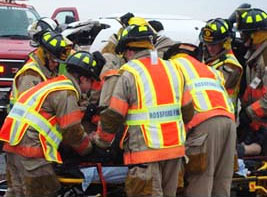Fire Department Vests In a four-year analysis of struck-by incidents involving fire and emergency medical responders conducted by the Emergency Responder Safety institute, there were some identifiable trends. Over 63% of the 121 struck-by incidents reviewed occurred at the scene of motor vehicle accidents (MVAs). Considering the number of MVAs that fire and EMS agencies respond to each year, we should not be surprised that the majority of struck-by incidents occurred at accident scenes. ANSI Reflective Vests and other high visibility apparel significantly improve the safety of First Responders at motor vehicle accident scenes. By their very nature, motor vehicle accidents cause responders to work on or near a roadway. This danger is precisely what the new Federal Highway Administration Rule 23 CFR Part 634 is all about. The rule requires the use of ANSI Reflective Safety Vests for all workers on or around Federal Aid Highways. Please see below for the rule. First Responders need to be especially vigilant and use the required reflective safety vests when on the scene of accidents on limited access roads where speeds are higher and driver reaction times are shorter. § 634.3 Rule All workers within the right-of-way of a Federal-aid highway who are exposed either to traffic (vehicles using the highway for purposes of travel) or to construction equipment within the work area shall wear high-visibility safety apparel. Firefighters or other emergency responders working within the right-of way of a Federal-aid highway and engaged in emergency operations that directly expose them to flame, fire, heat, and/or hazardous materials may wear retroreflective turn-out gear that is specified and regulated by other organizations, such as the National Fire Protection Association. Firefighters or other emergency responders working within the right-of-way of a Federal-aid highway and engaged in any other types of operations shall wear high-visibility safety apparel. [FR Doc. E8-27671 Filed 11-20-08; 8:45 am] When Should High-Visibility Safety Apparel Be Replaced? View our Safety Vests High-visibility safety apparel should be replaced when it becomes faded, torn, dirty, soiled, worn, or defaced, or if it is not visible at 1,000 feet day or night. The typical useful service life of high-visibility safety apparel depends on the type of work an individual performs while wearing the apparel. Apparel that is worn on a daily basis has a service life expectancy of approximately 6 months, although apparel that is not worn on a daily basis may have a useful service life of up to 3 years. When apparel is ready for replacement, notify your safety compliance officer or supervisor and request replacement apparel. Ensure that they know the kind of work you are doing (repaving, maintenance work, nighttime work, etc.) so that they will know which type of apparel to provide to you. Once you have received your new apparel, cut your old apparel in half so that it can't be reused and then dispose of it properly. Purchasing agents should consider the following when buying new safety apparel and safety vests: Working conditions (time of day,temperature, etc.). Class of apparel needed (Performance Class 2, or 3; Class 1 is unacceptable for any highway work. See brochure entitled: Worker Visibility Be Seen. Be Safe. New Requirements for High Visibility Garments- Contact ATSSA for more information.) Compliance with ANSI/ISEA 107-2004 and 207-2006. State and local standards and guidelines MUTCD section 6E, which gives the appropriate colors for the apparel. Developed by: American Traffic Safety Services Association 15 Riverside Parkway Suite 100 Fredericksburg, VA 22406-1022 Click here to search for Safety Vests by Style, ANSI Safety Class, Color, Material, or Price. |





